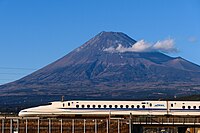
Photo from wikipedia
The high-speed train will exhibit different vibration characteristics when running on different lines. When the equivalent conicity of the wheel rail profile is larger, the critical speed of the vehicle… Click to show full abstract
The high-speed train will exhibit different vibration characteristics when running on different lines. When the equivalent conicity of the wheel rail profile is larger, the critical speed of the vehicle will decrease, which will lead to the lateral instability of bogie and cause the abnormal vibration problem of carbody. This paper firstly analyzes the causes of high-speed train’s body shaking when cross lines, through the test acceleration analysis and equivalent conicity analysis of measured wheel profile and rail profile, found that the main reason is equivalent conicity increases when the vehicle cross to another line and change of the wheel rail contact relationship. And establish the train model with the Simpack software, and the phenomenon of body shaking is reappeared by using the measured tread and rail profile, and the vibration of the carbody after crossing the line is obvious under the dominant frequency of 7.1 Hz. And proposes two optimization schemes: decreases the distance between backs of the wheel flanges and the optimization of suspension parameters. The simulation results show that the distance between backs of the wheel flanges decrease can effectively reducing the equivalent conicity, the equivalent conicity of 1353 mm, 1352 mm and 1351 mm were calculated respectively, and when the distance between backs of the wheel flanges was reduced by 1 mm and 2 mm, there was a significant decrease of equivalent conicity. The distance between backs of the wheel flanges decrease of 1 mm and 2 mm effectively reducing the equivalent taper, then the bogie lateral acceleration was reduced by 22.4 % and 30.7 %, the lateral acceleration of carbody is decreased by 8.87 % and 24.6 %. At the same time, optimize the anti-yaw vibration absorber stiffness and node positioning stiffness, increasing the longitudinal positioning stiffness and anti-yaw vibration absorber stiffness can effectively reduce the lateral acceleration of the bogie and carbody. However, the selection of this parameter should be combined with other dynamic indexes and wheel wear.
Journal Title: Journal of Mechanical Science and Technology
Year Published: 2019
Link to full text (if available)
Share on Social Media: Sign Up to like & get
recommendations!